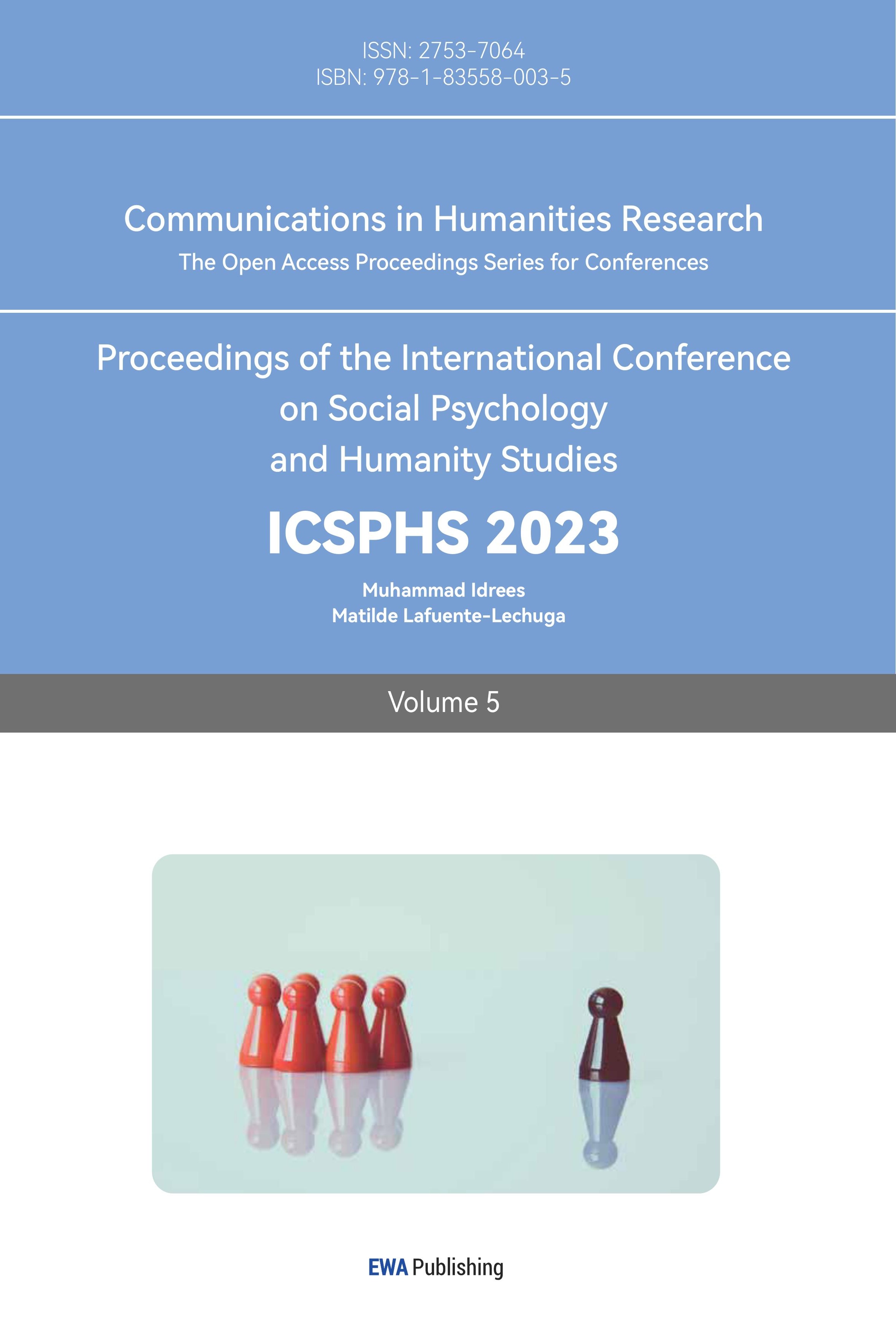1.Introduction
As globalization and international integration advance quickly, people from many cultures go to other nations to exchange ideas. As a result, the concept of cultural prosperity arises. The introduction of Korean pop (K-pop) music to the US is the greatest illustration of cultural exchange on a global scale. From many angles, K-pop music has had a significant influence on American music culture. Many dancers and singers have found greater inspiration in K-pop music, which has had a significant and lasting effect on the US [1]. American and Korean music cultures both have an impact on one another. During the colonial era, American and Japanese music had an impact on Korean music from the 19th to the 21st centuries [2]. This explains why K-pop is widely available in the US and is growing in popularity in this powerhouse. From this vantage point, it is clear that K-pop has a more significant and profound influence on American society. The influence of this Asian music on US culture will be examined in the sections that follow including relevant sources and research.
2.The Characteristics of K-pop Music
K-pop is a kind of music that makes use of a wide range of voices and sounds. Rapping, hip-hop, dancing breaks, quick melodies, and catchy beats are the key musical characteristics of this genre. Its songs are entirely composed and sung in English and Korean. In contrast to other music genres, K-pop is thought of as a brand-new genre that, via creation, has an impact on the international music industry. For instance, K-pop music has evolved into the pinnacle of the South Korean music business thanks to the rise and success of the BTS group in 2013. This musical ensemble has broken close to 25 Guinness World Records.
BTS consistently exudes style and intelligence, as was already said. In 2018, this ensemble achieved global fame. They have set the bar for the international business model in terms of aesthetics, individual creativity, individual talent, etc. The Korean government uses this organization to increase its recognition and reputation abroad because the amusement culture in South Korea may assist the country to boost its national image and reputation. The musical aesthetic of BTS represents K-pop on a worldwide scale. Other nations never had an organization like this one that might have such a negative influence on their national reputations can this [3].
Numerous academics have undertaken an in-depth study on the impact of BTS on a multinational audience. Lee and Kim (2020) examine the dance performance of BTS and the attitudes and views of their performance across a worldwide audience [4]. They conduct a poll with 498 participants, asking them to share their opinions on this band of musicians. It concludes that BTS's musical and dance performances can increase audience loyalty to the festival event [4]. From this point on, it is clear that BTS has impacted both brand loyalty and the international music business.
The worldwide entertainment culture has been significantly impacted by BTS and other K-pop groups like Blackpink. The emergence of BTS and Blackpink has made the growth of fandom and pop culture following more widely known [5]. From a different angle, the appeal of K-pop music to young listeners and the examination of art education in contemporary culture emerge as further qualities of the genre [6]. As was already noted, this has shown the characteristics of K-pop music culture from several angles.
3.How K-pop Music Enters the US
The global music business is becoming more and more attracted to K-pop music culture. Diverse nations have different musical styles. When Korean pop artist Park Jae-song’s song "Gangnam Style" becomes widely successful, K-pop culture formally penetrates the US market.
Scenes from Park Jae-rendition sang of Gangnam style are seen in the two images above. This music is distinguished by its captivating rhythms and lyrics, as well as by the appealing and distinctive dance style, which has drawn a wide range of listeners from all over the world. In Metropolia, this music is always audible on the streets and at every corner of supermarkets and retail centers [7]. It quickly entered the US market for quicker dissemination due to its popularity and unique musical style.
The number of people who have watched PSY's "Gangnam Style" has been rising all around the world, even in the US. According to the study, Nielsen Soundscan tracks all of this song's downloads in the US, as figure 1 shows. The amount of people who have downloaded this music in total is close to 638,000, and each download costs $1.29. It indicates that the final cost of all downloads will be $823,020 [8].
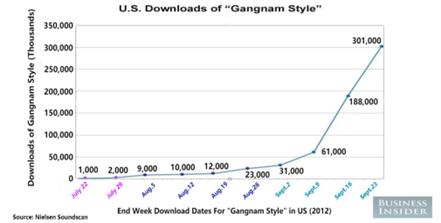
Figure 1: US Downloads of “Gangnam Style” [8].
The graphic up above demonstrates how the weekly downloads of the song Gangnam Style significantly increase from July to September of 2012. The overall number of downloads increased marginally from July to August. However, starting August 26, there has been a strong and quick increase in the number of downloads, indicating the popularity and allure of this particular K-pop musical genre in the US. This demonstrates that a bigger proportion of American listeners are open to accepting this musical genre as a means of conveying the happiness and insanity of their daily lives. It is important to pay close attention to this.
Due to its novelty and disruption of the country's established musical traditions, Gangnam Style has become extremely popular in the US. Everyone is open to trying something new if it would improve their lives. According to the data, Gangnam Style became YouTube's most-watched video in 2012, marking a significant advancement for K-pop music's absorption into the US market (Figure 2). It is important to pay close attention to this.
From a different angle, the popularity rivalry between K-pop and American local music might reveal interesting information about how K-pop music has effectively penetrated the US and impacted the locals of this potent industrialized nation.
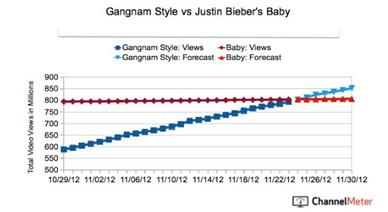
Figure 2: Gangnam Style vs Justin Bieber’s Baby [9].
This graph demonstrates that, prior to November 22, 2012, more people viewed the song Baby than Gangnam Style. After November 22, 2012, it is anticipated that Gangnam Style would have outperformed Baby in terms of total viewers. It demonstrates that, in the majority of situations, Gangnam Style is seen as the revolutionary music that captures the attention of all Americans. It is important to pay close attention to this. This indicates that this song is the first K-pop to reach the US market. Later, the majority of Americans love and listen to K-pop music in their daily lives. They also seek to incorporate Korean culture and industry into their own society [10].
Furthermore, the American public and fans help make this international K-pop music popular, which is another factor contributing to K-pop music's success in the US market [11]. The good attitudes and fearlessness of the passionate and vivacious Korean boy band BTS, who have deeply impacted the souls of American youth, have profoundly influenced the majority of young people in America [12]. This explains why K-pop music has been popular in the US for a longer period of time and how it got there.
4.The Impact of K-pop Music on the US Culture
From several angles, K-pop music has had an effect on US musical culture. It's incredible that South Korea can sell pop songs overseas directly. Western composers and producers are frequently used in K-pop music to make Korean music. K-pop has so introduced various particular cultures to the western style of music. Because of this, K-pop music can effectively and swiftly infiltrate the US market, maximizing the industry's potential. Furthermore, South Korea is adept at advertising its K-pop culture on various social media channels, such as YouTube, iTunes, Facebook, Twitter, and others, in order to penetrate the US market. K-pop music and music bands may also easily access Spotify and Instagram (Figure 3). As a result, they amass a following worldwide, and over time, Americans started to embrace K-pop music [13]. In this way, the quick expansion of the digital revolution has increased the popularity of K-pop music culture around the globe, including the US market. America also acknowledges that the music industry is changing, which may significantly advance the long-term growth and supremacy of the American music industry [14]. From this perspective, it is clear that American music firms and artists may benefit from the K-pop music genre in order to further the development of their own music and distinctive styles inside the country.
Additionally, K-pop music's use of blatantly western music and dance styles turns out to be another component that influences American music culture. American pop music and K-pop have reciprocal influences on one another. This has demonstrated that American music styles including hip-hop, R&B, and rock music, among others, are more prevalent in K-pop music [15]. Therefore, the Hallyu wave is the term used to describe K-success pop in the US. It also shows that since K-pop entered the US market, Korean cultures, foods, languages, and entertainment are also entering the market there for more cultural exchange. Synchronized dances, single-gender bands, matching clothes, etc. are common in K-pop music, which helped shape the Backstreet Boys in the US throughout the 1990s [16]. In this way, K-pop music in the US alters a variety of facets of American life. People with various viewpoints should pay close attention to this. A number of Americans start to copy and alter K-pop culture in order to create its distinct musical style [17]. This further highlights the growth in K-pop music's appeal over time in the US. In addition, K-pop music is progressively becoming part of American society.
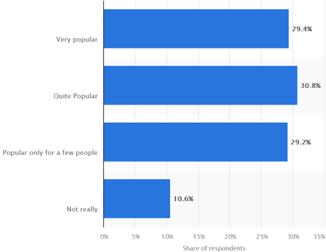
Figure 3: Popularity of South Korean pop music (K-pop) in the United States in 2019 [18].
The bar graph above depicts the popularity of K-pop music over the whole year of 2019 in the United States(Figure 3). It reveals that 30.8 percent of US citizens think K-pop music is pretty popular, 29.2 percent think it is popular only among a small number of people, and 29.4 percent say it is extremely popular. This information demonstrates the differences in K-pop music's popularity across the US. To put it another way, there are still some people who do not think that K-pop is a part of American society. This implies that they should constantly be modified and included in the American music business. It demonstrates that immigration is a common occurrence in the US since many people immigrate here in order to further their lives. The "melting pot" phenomenon has been aided by this. The US not only welcomes J-pop and K-pop music, but the US music industry also learns from them. By fusing these two pop music genres, the US has been able to create its own unique musical style. As a result, pop music from Asian nations is introduced to the US, where it can further the growth of the music business [19]. The impact of K-pop music on the world is constant and significant. It has helped the Korean music business expand internationally [20]. This demonstrates how well-liked K-pop is in the US market.
K-pop is well-recognized and adored by people all around the world. However, as compared to other nations, the US has the most popularity and dominance of K-pop music. The following map illustrates this fact (Figure 4).
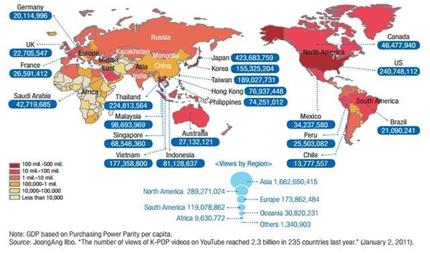
Figure 4: Number of views of K-pop videos on YouTube [20].
The heavy red tint on this map indicates the concentration of K-pop music fans in particular regions of the world. The majority of the dark red regions, which make up 240,748,112 in total, are found in the United States, making up the highest percentage when compared to other regions of the globe. This demonstrates that K-pop has had some significant and positive impacts on US culture. This has to be addressed in order to examine how K-pop music is incorporated into American music and entertainment culture from many angles. Additionally, it demonstrates how openly the US invites other cultures into its own because it is a multicultural and diverse country.
What's more, it demonstrates that a variety of musicians are instrumental in bringing K-pop to the US in a mainstream manner. South Korean artists play the role of fusing American culture with K-pop culture in the entertainment sector. Because some American composers started working with South Korean songwriters and singers during the second generation, K-pop has steadily gained popularity among US listeners. It is important to pay close attention to this. Its influence on the US depends not only on the development of talent and the idealistic creation of costumes and fashions but also on the well-known South Korean band [21]. In a certain manner, this has sped up the rate at which K-pop is developing in the US market.
American society is likewise impacted by K-pop music. K-pop music also has more comparable effects in the US. For many individuals, a lively and catchy tune is what most defines K-pop music. Even if some of the language or lyrics in K-pop songs are meaningless, they are nevertheless competitive, popular, and appealing [22]. K-pop music also makes more Americans aware of the existence of a different form of society abroad, inspiring them to adapt and catch up with the most rapid trend in the globe. In a similar vein, Americans are also introduced to Korean cuisine and lifestyle.
5.Conclusion
The major focus of this essay's conclusion is how K-pop has influenced American musical cultures in several ways. K-pop is mostly known for its humorous and catchy tunes, which appeal to a wide audience, especially young people. The beautiful music played by bands in this Asian country has a strong attraction to them. This sort of style is beloved by many Americans who want to bring K-pop music to their own nation. This study demonstrates how K-pop culture and other Asian cultures have entered the superpower country of America as a result of the rapid expansion of globalization.
References
[1]. Zheng, M, H (2018). Korean Pop Integration into American Music Culture, The Science Survey, https://thesciencesurvey.com/editorial/2018/03/01/korean-pop-integration-into-american-music-culture/
[2]. Stephen (2018). American Music Influence on Kpop in the Past and the Present, Ayo, GG, https://blogs.ubc.ca/asia327girlsgen/2018/10/01/american-music-influence-on-kpop-in-the-past-and-the-present/
[3]. Proctor, J (2020). Labour of Love: Fan Labor, BTS, and South Korean Soft Power, Asia Marketing Journal, 22 (4): 122-131. https://doi.org/10.15830/amj.2020.22.4.79
[4]. Lee, H, and Kim, J (2020). Brand Loyalty and the Bangtan Sonyeondan (BTS) Korean Dance: Global Viewers’ Perceptions, Journal of Psychology in Africa, 30 (6): 551-558. https://doi.org/10.1080/14330237.2020.1842415
[5]. Lee, Y., Oh, H and An, S (2020). Characteristics Analysis and Utilization Plans of K-pop Fandom Records for Popular Music Archives: Focused on the Case of BTS Fandom, A.R.M.Y, The Korean Journal of Archival Studies, 60 (2019): 161-194.
[6]. Kim, A (2017). Korean Popular Music (K-pop), Youth Fan Culture, and Art Education Curriculum, University of South Carolina, 2017.
[7]. Sherman, M (2021). K-pop Conquered the World. Now What? ELLE, https://www.elle.com/culture/music/a36898177/k-pop-multibillion-dollar-industry/
[8]. Acuna, K (2012). These Charts Show How “Gangnam Style” Went Crazy Viral, Insider, https://www.businessinsider.com/how-gangnam-style-became-huge-2012-10
[9]. Kafka, P (2012). All Hail Gangnam Style: YouTube’s Most Popular Video, Ever, All Things, https://allthingsd.com/20121124/all-hail-gangnam-style-youtubes-most-popular-video-ever/?mod=mailchimp
[10]. Kim, A and McGoun, E, G (2021). K-pop and K-car: The Underpinnings of 21st-Century Korean Cultural and Industrial Successes, Sciendo, 30 (2): 103-134. DOI: https://doi.org/10.7206/cemj.2658-0845.77
[11]. Tizzard, D, A (2022). Desiring Machines---Portrait of a K-pop Fan, from the book South Korean Popular Culture in the Global Context, Routledge, 2022.
[12]. Brennan, b (2020). The Korean Boy Band BTS Mapping the Soul, Journal of Analytical Psychology, 65 (5): 937-943.
[13]. Borman, B (2019). Achievement in the South Korean Music Industry, International Journal of Music Business Research, 8 (2): 6-26.
[14]. Parc, J and Kim, S, D (2020). The Digital Transformation of the Korean Music Industry and the Global Emergence of K-pop, Sustainability, 12 (18): 77-90. https://doi.org/10.3390/su12187790
[15]. Anderson, C, S (2020). Soul in Seoul: African American Popular Music and K-pop, University Press of Mississippi, 2020.
[16]. Yoon, K (2019). Diasporic Youth Culture of K-pop, Journal of Youth Studies, 22 (1): 138-152. https://doi.org/10.1080/13676261.2018.1496407
[17]. Yoon, K (2018). Global Imagination of K-pop: Pop Music Fans’ Lived Experiences of Cultural Hybridity, Popular Music and Society, 41 (4): 373-389. https://doi.org/10.1080/03007766.2017.1292819
[18]. Statista Research Department (2022). K-pop Popularity in the US 2019, Statista, https://www.statista.com/statistics/956042/south-korea-kpop-popularity-in-the-us/
[19]. Fraser, S (2020). Comparative Discourse on J-pop and K-pop: Hybridity in Contemporary Local Music, Korea Journal, 60 (1): 40-70. https://www.statista.com/statistics/956042/south-korea-kpop-popularity-in-the-us/
[20]. Choi, J and maliangkay, R (2014). Why Fandom Matters to the International Rise of K-pop, from the book: K-Pop--the International Rise of the Korean Music Industry, Routledge, 2014.
[21]. Cobb, C (2021). Breaking into the American Mainstream---Korean Pop’s Expansion and American Influences, Digital Commons, 2021.
[22]. Urlaub, M (2022). The Rise of K-Pop in the United States, The Daily Cardinal, 12 (7): 23-51.
Cite this article
Zhang,B. (2023). How Did K-pop Music Affect Americans?. Communications in Humanities Research,5,67-72.
Data availability
The datasets used and/or analyzed during the current study will be available from the authors upon reasonable request.
Disclaimer/Publisher's Note
The statements, opinions and data contained in all publications are solely those of the individual author(s) and contributor(s) and not of EWA Publishing and/or the editor(s). EWA Publishing and/or the editor(s) disclaim responsibility for any injury to people or property resulting from any ideas, methods, instructions or products referred to in the content.
About volume
Volume title: Proceedings of the International Conference on Social Psychology and Humanity Studies
© 2024 by the author(s). Licensee EWA Publishing, Oxford, UK. This article is an open access article distributed under the terms and
conditions of the Creative Commons Attribution (CC BY) license. Authors who
publish this series agree to the following terms:
1. Authors retain copyright and grant the series right of first publication with the work simultaneously licensed under a Creative Commons
Attribution License that allows others to share the work with an acknowledgment of the work's authorship and initial publication in this
series.
2. Authors are able to enter into separate, additional contractual arrangements for the non-exclusive distribution of the series's published
version of the work (e.g., post it to an institutional repository or publish it in a book), with an acknowledgment of its initial
publication in this series.
3. Authors are permitted and encouraged to post their work online (e.g., in institutional repositories or on their website) prior to and
during the submission process, as it can lead to productive exchanges, as well as earlier and greater citation of published work (See
Open access policy for details).
References
[1]. Zheng, M, H (2018). Korean Pop Integration into American Music Culture, The Science Survey, https://thesciencesurvey.com/editorial/2018/03/01/korean-pop-integration-into-american-music-culture/
[2]. Stephen (2018). American Music Influence on Kpop in the Past and the Present, Ayo, GG, https://blogs.ubc.ca/asia327girlsgen/2018/10/01/american-music-influence-on-kpop-in-the-past-and-the-present/
[3]. Proctor, J (2020). Labour of Love: Fan Labor, BTS, and South Korean Soft Power, Asia Marketing Journal, 22 (4): 122-131. https://doi.org/10.15830/amj.2020.22.4.79
[4]. Lee, H, and Kim, J (2020). Brand Loyalty and the Bangtan Sonyeondan (BTS) Korean Dance: Global Viewers’ Perceptions, Journal of Psychology in Africa, 30 (6): 551-558. https://doi.org/10.1080/14330237.2020.1842415
[5]. Lee, Y., Oh, H and An, S (2020). Characteristics Analysis and Utilization Plans of K-pop Fandom Records for Popular Music Archives: Focused on the Case of BTS Fandom, A.R.M.Y, The Korean Journal of Archival Studies, 60 (2019): 161-194.
[6]. Kim, A (2017). Korean Popular Music (K-pop), Youth Fan Culture, and Art Education Curriculum, University of South Carolina, 2017.
[7]. Sherman, M (2021). K-pop Conquered the World. Now What? ELLE, https://www.elle.com/culture/music/a36898177/k-pop-multibillion-dollar-industry/
[8]. Acuna, K (2012). These Charts Show How “Gangnam Style” Went Crazy Viral, Insider, https://www.businessinsider.com/how-gangnam-style-became-huge-2012-10
[9]. Kafka, P (2012). All Hail Gangnam Style: YouTube’s Most Popular Video, Ever, All Things, https://allthingsd.com/20121124/all-hail-gangnam-style-youtubes-most-popular-video-ever/?mod=mailchimp
[10]. Kim, A and McGoun, E, G (2021). K-pop and K-car: The Underpinnings of 21st-Century Korean Cultural and Industrial Successes, Sciendo, 30 (2): 103-134. DOI: https://doi.org/10.7206/cemj.2658-0845.77
[11]. Tizzard, D, A (2022). Desiring Machines---Portrait of a K-pop Fan, from the book South Korean Popular Culture in the Global Context, Routledge, 2022.
[12]. Brennan, b (2020). The Korean Boy Band BTS Mapping the Soul, Journal of Analytical Psychology, 65 (5): 937-943.
[13]. Borman, B (2019). Achievement in the South Korean Music Industry, International Journal of Music Business Research, 8 (2): 6-26.
[14]. Parc, J and Kim, S, D (2020). The Digital Transformation of the Korean Music Industry and the Global Emergence of K-pop, Sustainability, 12 (18): 77-90. https://doi.org/10.3390/su12187790
[15]. Anderson, C, S (2020). Soul in Seoul: African American Popular Music and K-pop, University Press of Mississippi, 2020.
[16]. Yoon, K (2019). Diasporic Youth Culture of K-pop, Journal of Youth Studies, 22 (1): 138-152. https://doi.org/10.1080/13676261.2018.1496407
[17]. Yoon, K (2018). Global Imagination of K-pop: Pop Music Fans’ Lived Experiences of Cultural Hybridity, Popular Music and Society, 41 (4): 373-389. https://doi.org/10.1080/03007766.2017.1292819
[18]. Statista Research Department (2022). K-pop Popularity in the US 2019, Statista, https://www.statista.com/statistics/956042/south-korea-kpop-popularity-in-the-us/
[19]. Fraser, S (2020). Comparative Discourse on J-pop and K-pop: Hybridity in Contemporary Local Music, Korea Journal, 60 (1): 40-70. https://www.statista.com/statistics/956042/south-korea-kpop-popularity-in-the-us/
[20]. Choi, J and maliangkay, R (2014). Why Fandom Matters to the International Rise of K-pop, from the book: K-Pop--the International Rise of the Korean Music Industry, Routledge, 2014.
[21]. Cobb, C (2021). Breaking into the American Mainstream---Korean Pop’s Expansion and American Influences, Digital Commons, 2021.
[22]. Urlaub, M (2022). The Rise of K-Pop in the United States, The Daily Cardinal, 12 (7): 23-51.





